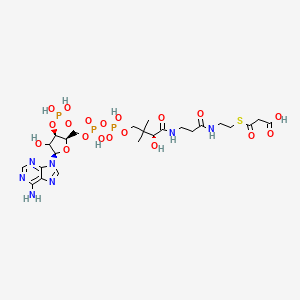| MeSH term | MeSH ID | Detail |
|---|---|---|
| Diabetes Mellitus | D003920 | 90 associated lipids |
| Adenocarcinoma | D000230 | 166 associated lipids |
| Reperfusion Injury | D015427 | 65 associated lipids |
| Diabetes Mellitus, Type 2 | D003924 | 87 associated lipids |
| Fatty Liver | D005234 | 48 associated lipids |
| Ketosis | D007662 | 13 associated lipids |
| Body Weight | D001835 | 333 associated lipids |
| Heart Failure | D006333 | 36 associated lipids |
| Prostatic Neoplasms | D011471 | 126 associated lipids |
| Hypothyroidism | D007037 | 32 associated lipids |
Lmfa07050031
Lmfa07050031 is a lipid of Fatty Acyls (FA) class. The involved functions are known as Pigment and Polymerization. The related lipids are Propionate.
Cross Reference
Introduction
To understand associated biological information of Lmfa07050031, we collected biological information of abnormalities, associated pathways, cellular/molecular locations, biological functions, related genes/proteins, lipids and common seen animal/experimental models with organized paragraphs from literatures.
What diseases are associated with Lmfa07050031?
There are no associated biomedical information in the current reference collection.
Possible diseases from mapped MeSH terms on references
We collected disease MeSH terms mapped to the references associated with Lmfa07050031
PubChem Associated disorders and diseases
What pathways are associated with Lmfa07050031
There are no associated biomedical information in the current reference collection.
PubChem Biomolecular Interactions and Pathways
Link to PubChem Biomolecular Interactions and PathwaysWhat cellular locations are associated with Lmfa07050031?
There are no associated biomedical information in the current reference collection.
What functions are associated with Lmfa07050031?
Related references are published most in these journals:
| Function | Cross reference | Weighted score | Related literatures |
|---|
What lipids are associated with Lmfa07050031?
Related references are published most in these journals:
| Lipid concept | Cross reference | Weighted score | Related literatures |
|---|
What genes are associated with Lmfa07050031?
There are no associated biomedical information in the current reference collection.
What common seen animal models are associated with Lmfa07050031?
There are no associated biomedical information in the current reference collection.
NCBI Entrez Crosslinks
All references with Lmfa07050031
Download all related citations| Authors | Title | Published | Journal | PubMed Link |
|---|---|---|---|---|
| Jackson VN et al. | Sequencing and functional expression of the malonyl-CoA-sensitive carnitine palmitoyltransferase from Drosophila melanogaster. | 1999 | Biochem. J. | pmid:10417309 |
| Bao W et al. | The Streptomyces peucetius dpsC gene determines the choice of starter unit in biosynthesis of the daunorubicin polyketide. | 1999 | J. Bacteriol. | pmid:10419974 |
| Zhou P et al. | Polyketide synthase acyl carrier protein (ACP) as a substrate and a catalyst for malonyl ACP biosynthesis. | 1999 | Chem. Biol. | pmid:10421763 |
| Sugden MC et al. | Hyperthyroidism facilitates cardiac fatty acid oxidation through altered regulation of cardiac carnitine palmitoyltransferase: studies in vivo and with cardiac myocytes. | 1999 | Horm. Metab. Res. | pmid:10422724 |
| Dreier J et al. | Kinetic analysis of the actinorhodin aromatic polyketide synthase. | 1999 | J. Biol. Chem. | pmid:10455191 |
| Funa N et al. | A new pathway for polyketide synthesis in microorganisms. | 1999 | Nature | pmid:10476972 |
| Sargueil F et al. | High metabolism and subsequent elongation of 3-hydroxyeicosanoyl-CoA in very-long-chain fatty acid deficient PNS of Trembler mice. | 1999 | Neurosci. Lett. | pmid:10505644 |
| Goodwin GW and Taegtmeyer H | Regulation of fatty acid oxidation of the heart by MCD and ACC during contractile stimulation. | 1999 | Am. J. Physiol. | pmid:10516138 |
| Zammit VA | The malonyl-CoA-long-chain acyl-CoA axis in the maintenance of mammalian cell function. | 1999 | Biochem. J. | pmid:10527927 |
| Laybutt DR et al. | Muscle lipid accumulation and protein kinase C activation in the insulin-resistant chronically glucose-infused rat. | 1999 | Am. J. Physiol. | pmid:10600797 |
